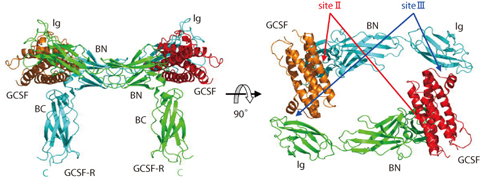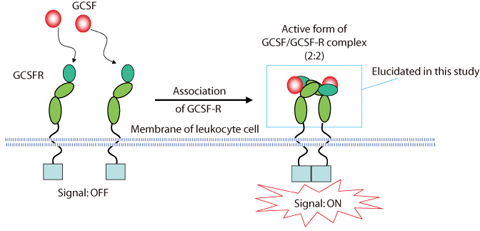
Fig.4-18 Overall structure of the signaling complex consisting of human GCSF and human GCSF-R

Fig.4-19 Activation mechanism of GCSF-R
The crystal structure of the signaling complex of human granulocyte colony-stimulating factor (hGCSF) and ligand binding region of hGCSF receptor (hGCSF-R) has been determined (Fig.4-18). The hGCSF is a glycoprotein consisting of about 180 amino acids, and is a cytokine for medical treatment of patients suffering from granulocytopenia which acts by causing the maturation proliferation, and differentiation of the precursor cells of neutrophilic granulocyte. Binding of hGCSF to the extracellular region of its receptor triggers receptor association, resulting in activation of a signaling cascade. Although hGCSF is an important protein not only for basic science but also for therapeutic use, the detailed activation mechanism of hGCSF-R has not been clarified.
We have already succeeded in preparation of the extracellular region of hGCSF-R, and demonstrated a 2:2 stoichiometry of the stable hGCSF/hGCSF-R complex in solution by thermodynamic analysis. Moreover, we have succeeded in crystallization of this sample and determined its tertiary structure by X-ray crystallography. The crystal structure revealed the atoms involved in the molecular positioning and recognition for the 2:2 complex; there is ligand-receptor interaction at two locations (site II and III) (Fig.4-18). Thus, the homodimerization of receptors by this 2:2 complex is elucidated to be an important feature for hGCSF-R activation (Fig.4-19).
This structural information may allow us to synthesize an agonist more efficiently. This study was cooperative research with Kirin Brewery and was partly supported as a Pilot Applied Research Project for the industrial use of space by Japan Space Utilization Promotion Center and Japan Aerospace Exploration Agency, and supported by the Protein 3000 Project and a Grant-in-Aid for Scientific Research (C) from Ministry of Education, Culture, Sports, Science and Technology, Japan.